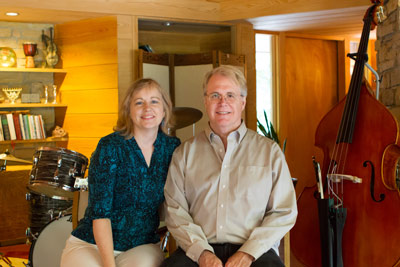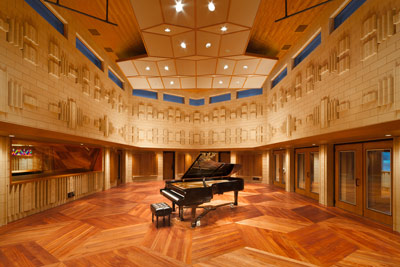By Taylor Sisk
Staff Writer
“Think of a kaleidoscope,†Wes Lachot says in explaining how he sees his work, describing notes and chords and architectural blueprints.
Lachot is the founder of Wes Lachot Design, a Chapel Hill-based, world-class designer of sound studios.

“When I look at jazz harmonies on a piano,†Lachot continues, “I see this pattern; it’s a pattern in a kaleidoscope sort of way, with symmetry to it.â€
That too is how he views architecture – as an organic system of patterns. For Lachot, architecture and music become one, and the nexus is found in rooms designed specifically for sound. For music. For beautiful music.
“Rooms have symmetry and they have shapes, and those shapes actually make notes, like a drum has a certain note because it’s a certain size, a flute makes a certain note because it’s a certain size,†Lachot explains.
“People talk about tuning rooms, but you really can only tune a room when you design a room; you’re setting the parameters to what it’ll be tuned to.â€
“I have a friend who calls Wes the Jedi of studio design,†says Robert George of Sound Temple Studios, a Lachot-designed space in Asheville. “I think that term fits.
“He’s very smart, and he has an intuitive sense too.â€
That intuition has guided Lachot to where he was already destined.
Music from the start
The oldest of five, Lachot, 56, was born in Raleigh. The family lived in Charlotte for a few years before his father, who’s in the insurance business, relocated to Morganton.
His father, Bill Lachot, sang in the church choir and in barbershop quartets, “but it was Mom who really drove it. She played the piano by ear, like I do; she played boogie woogie, just taught herself a lot of stuff like that.â€
His mother, Rowena Gee Lachot, had her kids enrolled in piano and violin lessons, dancing too, all at a very young age.
“My parents got me this little kids’ turntable with these little colored plastic records, and I used to sit there and spin records when I was, like, 1 year old,†Lachot recalls. “‘How Much is that Doggie in the Window,’ stuff like that.â€
And cowboy songs.
“That’s why I wanted a guitar when I was 4, because cowboys had them. … If cowboys had played the flute, I would have wanted to play the flute. But they got me the guitar.â€
He was into Bach and Beethoven, and then, in the second grade, came the Beatles, to whom he remains dearly devoted.
There were other early influences: In third grade, he took up the violin to impress a girl. “She played the violin, and for some reason I thought it would impress her. It didn’t.â€
Then, when he was 11, the famous Columbus Boychoir (now called the American Boychoir), from the Columbus Boychoir School, came to Morganton.
For years, every Christmas Eve, his mother had listened to the choir perform “Amahl and the Night Visitors†on the radio. When the choir arrived to play the community concert series, Lachot’s mother took him, slipping his violin into the trunk of the car. He auditioned after the show and, a week later, found himself on the choir’s Princeton, N.J., campus, a place called Albemarle.
The patterns
It was at Albemarle – a 600-acre estate with a 60-room mansion, gardener’s cottage, rose garden, grand oval – that Lachot discovered his love for architecture.
“The guy who designed the grounds was an apprentice of [Frederick Law] Olmstead. … I used to walk around and notice how all the gazebos were aligned symmetrically and how the garden walls curved around symmetrically. It was just an amazing place.â€
His father took the family to the 1967 World’s Fair in Montreal, where a Buckminster Fuller geodesic dome was on display.
“I stood there for an hour trying to figure out the pattern of how the pentagons and hexagons work together to make that dome. I still think about that stuff.â€
A fascination was fostered, one that melded quite naturally with his music.
Meanwhile, he was being steeped in music theory, “which I use every day in my work, as it relates to geometry, because they’re all sort of one thing.â€
After three years with the choir, his voice having changed, Lachot returned to Morganton to play in rock bands and impress more girls, before leaving home once again to attend the Berklee College of Music in Boston, where he studied jazz.
He came to this area in 1979, having visited Chapel Hill while spending a travel year between high school and college, and fell in with the music crowd. In 1983, he opened a recording studio in Carrboro that came to be called Overdub Lane. Among the artists he produced over the next dozen years were the Pressure Boys, the Vanguard Jazz Orchestra and John Hartford.
Focusing on music all day can be a beautiful thing; it can also, by the end of that day, fry a man’s brain. Lachot would return home to his wife, Lisa, after a full day of engineering, hungry for silence. As a diversion, he returned to his love of architecture, devouring books on the art by the dozens.
“Architecture is visual music,†Lachot says. “It’s completely silent, and yet it’s like music in terms of its structure and beauty.â€
His absorption deepened. “I’d be up all night, and Lisa would say, ‘What are you doing?’ ‘I’m studying architecture.’ It became an obsession … and without realizing it, I became an expert on architecture. I had no idea why I was doing it; I was just doing it because it was silent and it engaged that same part of my brain that music does.â€
His eureka moment in studio design came when he realized that “the correct angles for doing what you need acoustically are also aesthetically very beautiful ones. This was the kind of thing that Frank Lloyd Wright and Buckminster Fuller were into, but not for acoustical reasons.
“That really made me happy.â€
His interests had fully converged. “I was into the domes and all this stuff, but had had no idea they’d ever apply to the acoustics.†But they did.

And so he merged the two in practice, first designing studios for a few friends, including Fidelitorium Recordings in Kernersville for Mitch Easter, who’s produced albums for REM and the dB’s, among a number of other critically acclaimed players.
Of architecture, Lachot says, “It’s basically a love of symmetry; that’s what it comes down to. It’s the same part of my brain that’s engaged by music theory and jazz harmonies. It’s all like a kaleidoscope.â€
“I actually sit at the piano and work out the shapes of rooms as chords on the piano. It helps me to see it more clearly.â€
Lachot works using the principles of “organic architecture,†integrating acoustic and structural design into a unified whole.
Last year, he completed design on the main studio of Manifold Recording – a gorgeous, state-of-the-art 5,600-square-foot complex on 17 acres near Jordan Lake – for Red Hat vice president Michael Tiemann.
Tiemann says that with a background in science, music and math, he himself understood the power of a unifying theory, “be it a theory of acoustics, architecture or aesthetics,†but that Lachot “took the time to help me understand the theory not as a set of arbitrary rules but as a way of understanding the design world around me.â€
“One of my favorite features of the studio is the fact that each individual acoustic space can be coupled with adjacent spaces to create yet-new acoustic palettes,†Tiemann says.
In addition to sounding great together, Manifold’s coupled spaces look and feel great together. “And everything works consistently, whether in isolation, conjunction or as a whole,†Tiemann says. “It is marvelous!â€
Team sport
Lachot still owns Overdub Lane, now located in Durham. He’s produced two records in the past year, for local artists he really admires, Steve March and Nancy Middleton. He also uses the studio as a laboratory to test new gear.
Designing and building studios, he says, is a team sport, and he has a great team with which he works all over the world.
Tony Brett runs Brett Acoustics in Durham, building acoustical materials and installing them wherever Lachot goes – from Pittsboro to Chicago to Santa Barbara to Dubai. He also works very closely with electrician Thom Canova. Lisa runs the business, and Overdub too. Rob Warren is his draftsman.
“That’s a huge asset,†Robert George says of this tight-knit team. “It was like everything was shorthand with them.â€
“Without knowing these guys are managing these projects,†Lachot says, “I’d go completely insane.â€
They have eight or 10 projects rolling at present. Lachot is excited about the Dubai project, which is in a downtown skyscraper, commissioned by a pop-rock aficionado who “wanted to build the nicest studio in the Middle East.â€
He’s also jazzed about a project in Slovenia, in the region from which the maple used to make Stradivarius and other quality violins comes. Lachot has craftsmen working on the studio using that same maple, from the same mountains.
He loves projects that begin with nothing more than a concept – no pre-existing structures – from which he can then dream up everything, from stained-glass diffusors to garden paths and tree lines.
But: “I don’t have a dream project that’s already formulated in my head, because every design is a solution to a particular problem.
“Frank Lloyd Wright said that the solution to every problem is contained within itself.â€
If you’re faced with a very difficult architectural problem, you don’t try to design your way out of it until you thoroughly understand the problem. In studying the problem, what you eventually realize is that “the solution is just the flip side of the problem. Once you completely understand the problem, the solution is obvious.
“And that’s the fun of it – somebody saying, ‘I’ve got a piece of property; it’s right by the ocean, but it’s really skinny.â€
So you begin to figure out how to work with this skinny piece of property.
“Something brilliant and unique will come out of that,†Lachot affirms, “and that skinniness will be an asset. If it hadn’t been so skinny and screwed up, it wouldn’t have been so unique and cool.â€
What began as the problem, ultimately defines its coolness.
“Otherwise,†Lachot says, “you would have stuck with the more mundane.â€
And who wants to listen to that?

